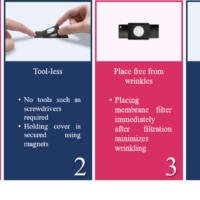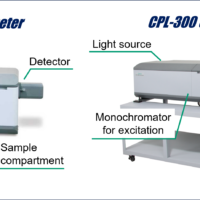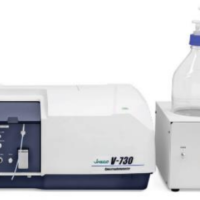Qualitative analysis
In most cases, identification of a sample component is performed by comparing its retention time with that in a standard sample. If a complex chromatogram with many peaks is obtained or if the retention time of the target component differs between the standard and the actual sample, the target component is identified by adding the standard sample to the unknown sample (Fig. 11). Analyzing the HPLC-collected components by IR or mass spectroscopy enables reliable qualitative analysis.
Fig. 11 Identification by comparing retention times in a standard sample (upper) and an unknown sample (lower)
Quantitative analysis
There are two methods for quantification: the external and internal standard methods, both of which are performed using a calibration curve. The external standard method creates a calibration curve for a standard sample and unknown samples are quantified using the calibration. In the internal standard method, a fixed amount of an internal standard substance is added to an unknown sample when creating a calibration curve using a standard sample, and a calibration curve is created with the concentration ratio vs. peak area ratio for quantification.
As shown in Fig. 12, the internal standard substance is required to be a component not included in the actual sample, to produce peaks that are completely separable from those for any contamination components, to elute at a retention time close to the quantitative target component, to be chemically and physically stable, and to be highly pure.
The advantage of the internal standard method is that it prevents errors in the injection volume or those caused by evaporation of the solvent.
Fig. 12 Quantification by internal standard method, calibration curve (left) and chromatogram (right)
Procedure for establishing analysis conditions
The procedure for establishing the analysis conditions is summarized below.
Step 1 Clarify the purpose of the analysis and investigate the components to be analyzed:
- Molecular weight, molecular structure and functional groups of components
- Properties (solubility, stability, UV/Vis or fluorescence spectrum, etc.) of components
- Sample state (content, concentration, impurities)
- Preliminary examination of analysis conditions and pretreatment based on data sheet and literature
Step 2 Consider analysis conditions for the column, mobile phase conditions, temperature, separation method and detection method:
- Confirmation of component peaks in standard samples using relatively high concentrations and examination of separation conditions
- Measurement at the required concentration, determination of detection method
Examination of pretreatment of unknown samples - Confirmation of separation of target components and contaminants in unknown samples
Step 3 Determination of analysis conditions that can be used for routine measurements
- Determination of calibration curve linearity and calibration curve type
- Quantitative reproducibility including pretreatment
- Confirmation of components that are strongly retained in the column and components that are not detected by the detector
- Correlation with other quantitative methods
Step 4 Routine quantitative analysis
- Column lifetime
- Running cost
- Clarification of measurement procedure and documentation
- System and column maintenance






